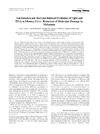Please use this identifier to cite or link to this item:
https://accedacris.ulpgc.es/jspui/handle/10553/76970
| Title: | Autoxidation and toxicant-induced oxidation of lipid and DNA in monkey liver: Reduction of molecular damage by melatonin | Authors: | Cabrera, Javier Burkhardt, Susanne Tan, Dun-Xian Manchester, Lucien C. Karbownik, Malgorzata Reiter, Russel J. |
UNESCO Clasification: | 3209 Farmacología | Keywords: | Pineal Hormone Melatonin Antioxidants Toxicology Pharmacology |
Issue Date: | 2001 | Journal: | Pharmacology and Toxicology | Abstract: | Melatonin, the main secretory product of the pineal gland, is a free radical scavenger and antioxidant which protects against oxidative damage due to a variety of toxicants. However, there is little information regarding melatonin's antioxidative capacity in tissues of primates. In this study we examined the protective effects of melatonin in monkey liver homogenates against lipid damage that occurred as a result of autoxidation or that induced by exogenous addition of H2O2 and ferrous iron (Fe2+). Additionally, we tested melatonin's protective effect against oxidative damage to DNA induced by chromium(III) (CrIII) plus H2O2. The levels of malondialdehyde and 4-hydroxyalkenals were assayed as an index of lipid peroxidation, and the concentrations of 8-hydroxydeoxyguanosine (8-OHdG) as an endpoint of oxidative DNA damage. The increases in malondialdehyde+4-hydroxyalkenals concentrations as a consequence of autoxidation or after the addition of H2O2 plus Fe2+ to the homogenates were time-dependent. The accumulation of these damaged products due to either autoxidative processes or induced by H2O2 and Fe2+ were significantly reduced by melatonin in a concentration-dependent-manner. The levels of 8-OHdG were elevated in purified monkey liver DNA incubated with a combination of CrCl3 plus H2O2. This rise in oxidatively damaged DNA was prevented by 10 muM concentration of melatonin. Also, melatonin reduced the damage to DNA that was caused by autoxidative processes. These findings in monkey liver tissue document the ability of melatonin to protect against oxidative damage to both lipid and DNA in primate tissue, as observed previously in rodent tissue. The findings provide support for the use of melatonin as suitable agent to reduce damage inflicted by free radical species in primates. | URI: | https://accedacris.ulpgc.es/handle/10553/76970 | ISSN: | 0901-9928 | DOI: | 10.1111/j.1600-0773.2001.890502.x | Source: | Pharmacology and Toxicology [ISSN 0901-9928], v. 89 (5), p. 225-230, (Noviembre 2001) |
| Appears in Collections: | Artículos |
SCOPUSTM
Citations
21
checked on Jun 8, 2025
WEB OF SCIENCETM
Citations
20
checked on Feb 25, 2024
Page view(s)
123
checked on May 31, 2025
Download(s)
190
checked on May 31, 2025
Google ScholarTM
Check
Altmetric
Share
Export metadata
Items in accedaCRIS are protected by copyright, with all rights reserved, unless otherwise indicated.
